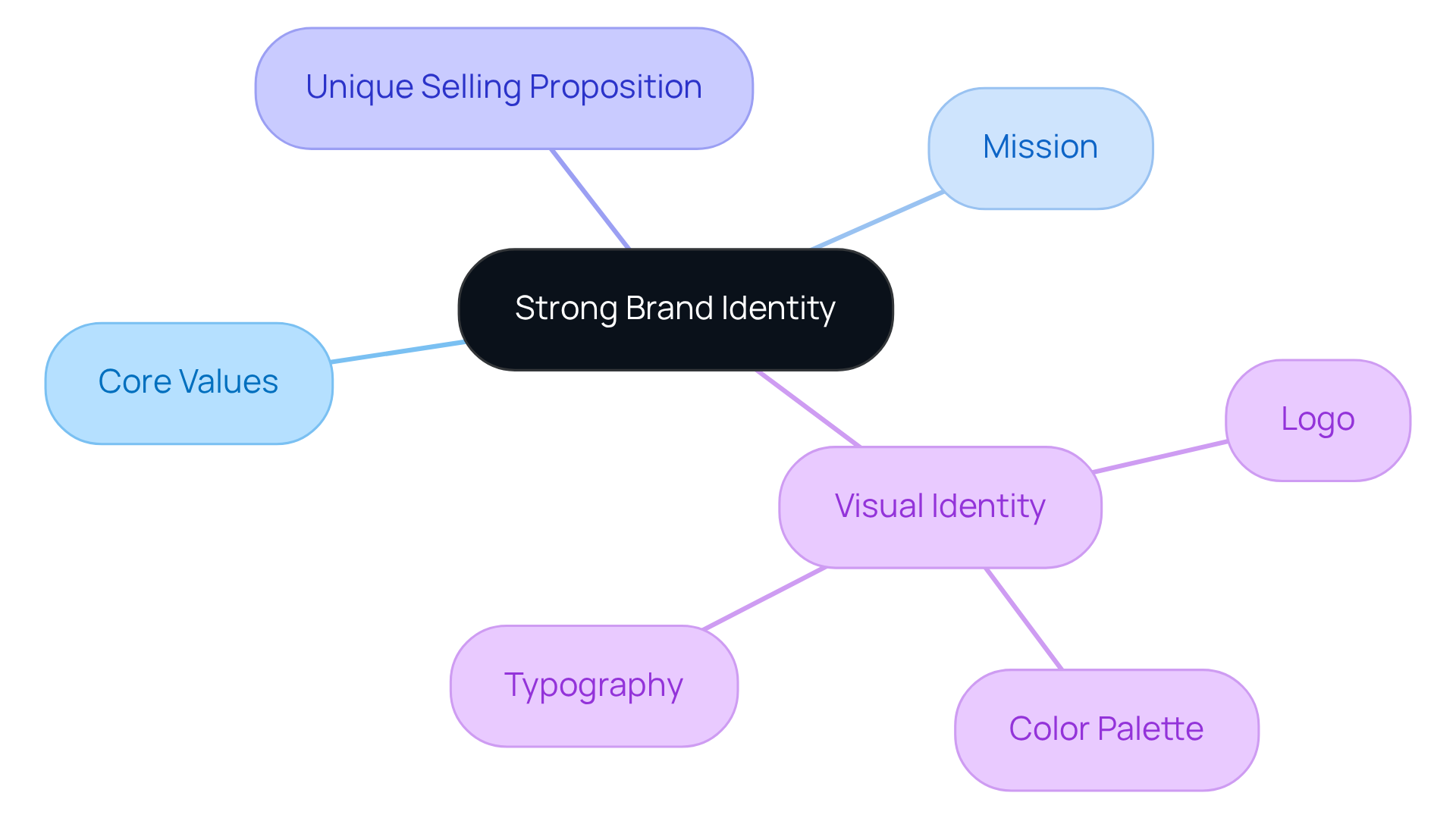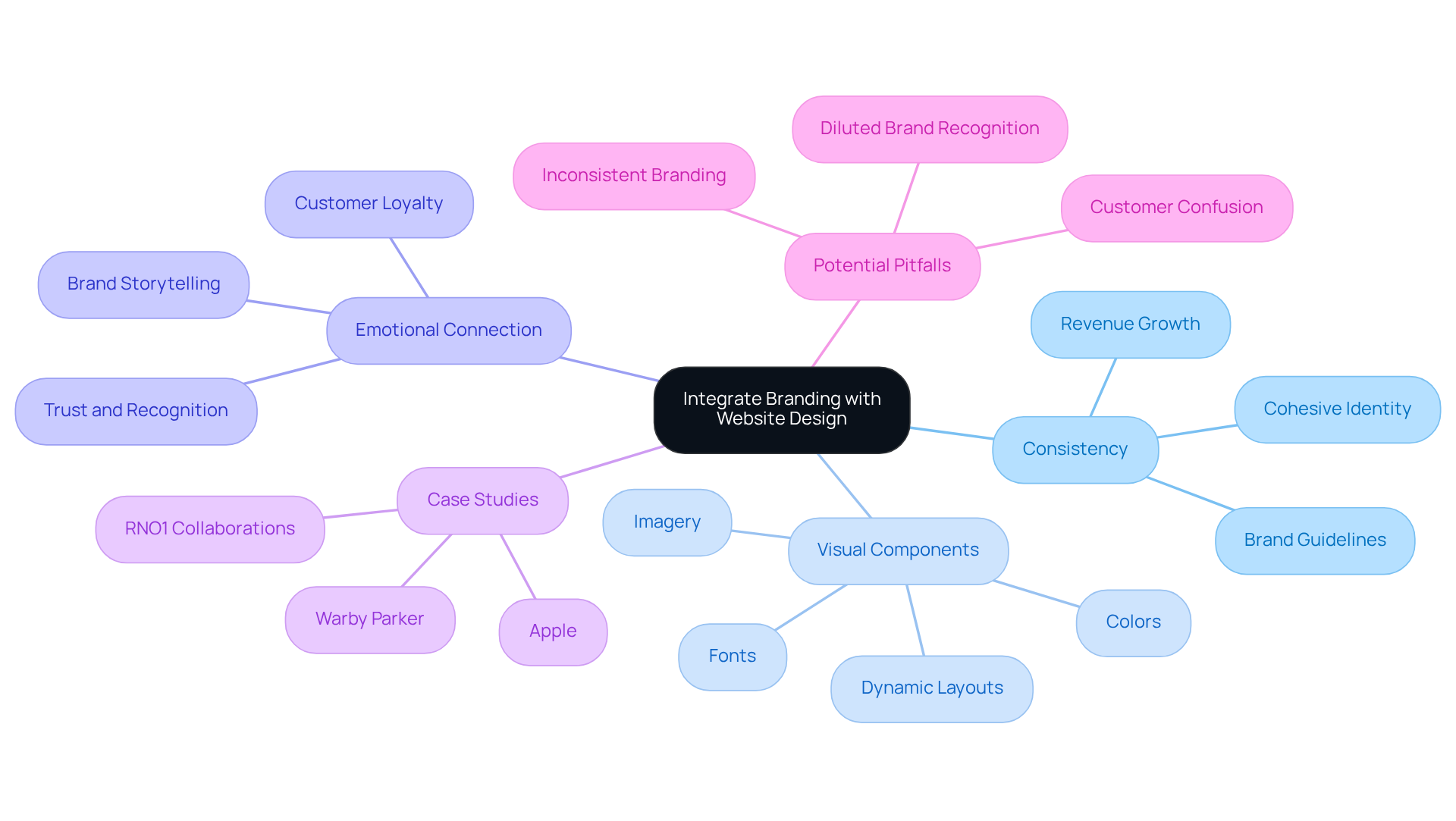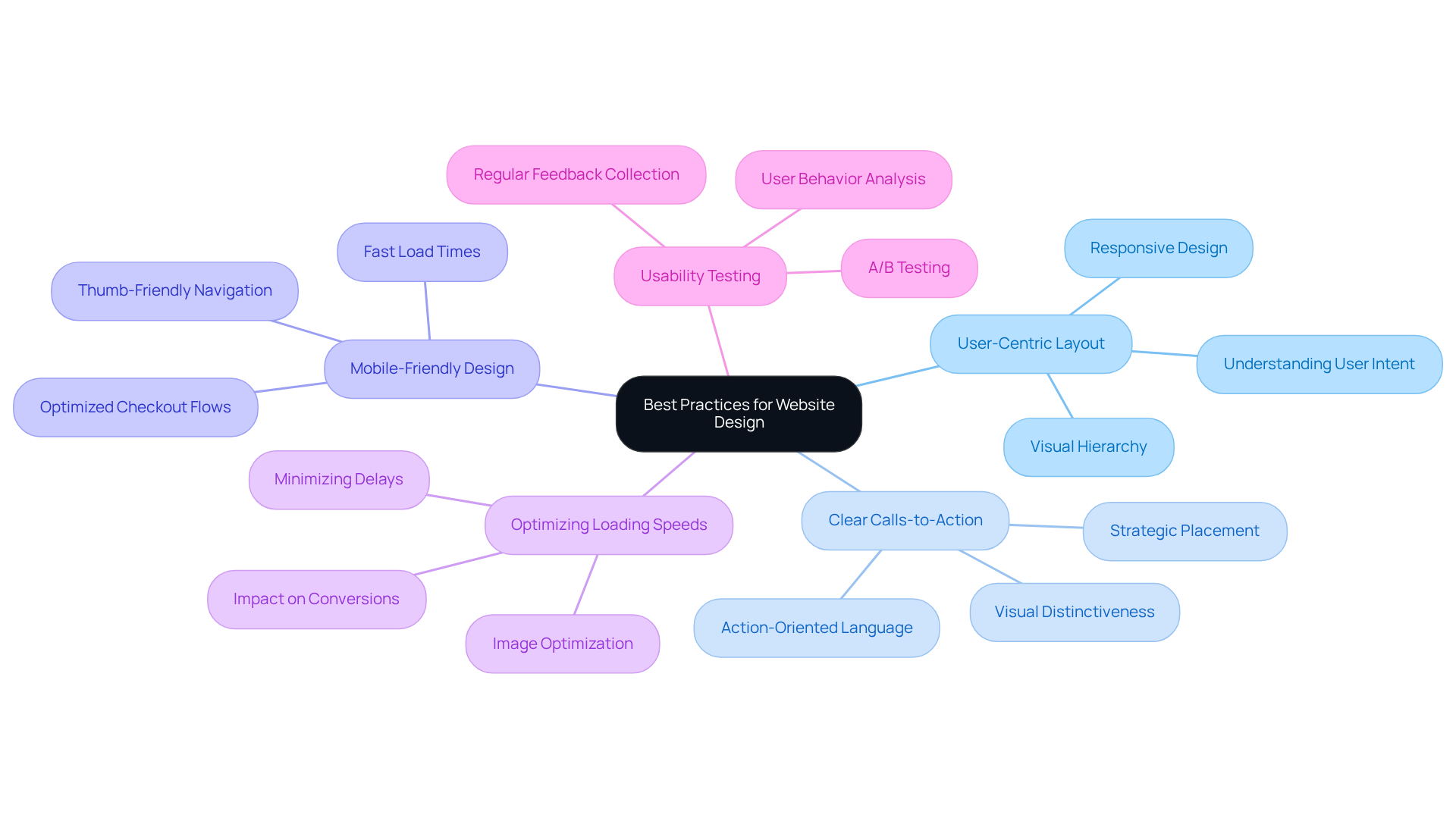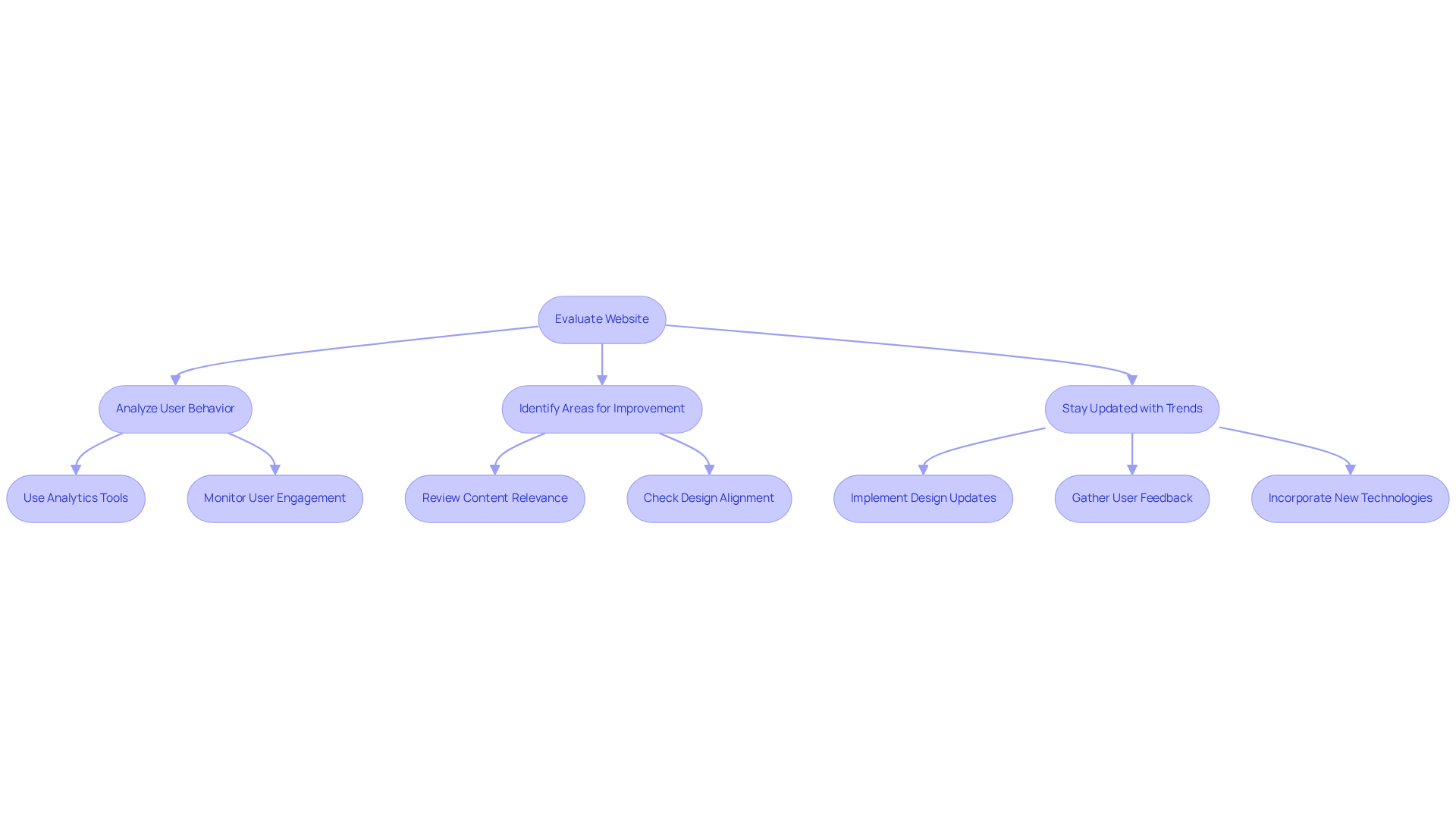Overview
Many tech startup founders struggle with effectively establishing their brand online. This challenge can lead to a lack of recognition and engagement, leaving founders feeling frustrated and disconnected from their audience. The emotional weight of this issue is significant; without a strong brand identity, it becomes difficult to foster customer loyalty and drive revenue.
However, there are best practices that can help alleviate these concerns:
- Establish a strong brand identity
- Integrate branding seamlessly with website design
- Implement user-centric practices
- Continuously optimize the website
It's essential to remember that consistency, emotional connection, and user experience are key components that enhance brand recognition and engagement. By focusing on these areas, you can nurture a loyal customer base that resonates with your brand's values and vision.
Introduction
In today's digital landscape, creating a memorable online presence has become crucial. Many businesses face the daunting challenge of ensuring that their digital interactions positively shape consumer perceptions. Effective brand design on websites is not merely about aesthetics; it communicates a company's core values and fosters a genuine connection with users. This connection is vital, as it ultimately influences engagement and loyalty. Yet, the struggle to harmonize branding with user-friendly design often leaves many feeling overwhelmed and uncertain.
How can we create a cohesive and impactful online experience? What best practices can we implement to ensure that our brand identity resonates throughout our website, captivating visitors and driving conversions?
Together, we can explore solutions that not only address these concerns but also empower you to build a nurturing online space for your audience.
Establish a Strong Brand Identity
Creating a strong identity for your business can often feel overwhelming. Many startup founders struggle to clearly define their core values, mission, and unique selling proposition. This uncertainty can lead to confusion about how to connect with your target audience and stand out among competitors. By conducting thorough market research, you can gain valuable insights into the needs and preferences of your audience, as well as the strengths and weaknesses of your competitors.
Once you have a clearer understanding, consider developing a visual identity that truly reflects your company’s personality. This includes:
- Crafting a memorable logo
- Choosing a cohesive color palette
- Selecting typography that resonates with your audience
It’s essential that your identity voice is not only clear but also nurturing, allowing your audience to feel a genuine connection with your brand. For example, tech startups like Slack have successfully established their identity around simplicity and user-friendliness, evident in their clean aesthetic and friendly tone.
Consistency across all components of your online presence and digital channels will significantly strengthen your identity and enhance its recognizability. Remember, you’re not alone in this journey; many founders share similar experiences. By focusing on these foundational aspects, you can develop a brand design website that not only stands out but also fosters a sense of community and support among your audience.

Integrate Branding with Website Design
To effectively merge marketing with their brand design website aesthetics, many founders face the challenge of maintaining consistency across all visual components, such as colors, fonts, and imagery, in alignment with their brand identity. This inconsistency can lead to confusion among potential customers, diluting brand recognition and impacting overall engagement. By strategically utilizing a cohesive color scheme throughout the site, you can create an appealing appearance that resonates with visitors. For instance, companies that emphasize innovation often incorporate contemporary visual elements like bold typography and dynamic layouts, which can significantly enhance their online presence.
Moreover, the tone of your online content should reflect your company's voice, enriching the overall experience for your audience. Take Apple's website as a prime example; it employs a minimalist design paired with clear messaging to embody its ethos of simplicity and sophistication. This thoughtful alignment not only enhances visual attractiveness but also fosters a deeper emotional bond with individuals. Research shows that customers who feel emotionally connected to a brand possess three times greater lifetime value, highlighting the importance of this connection.
RNO1 exemplifies this approach through its collaborations with various companies, including RentMethod, which successfully transitioned to acquisition by Airbnb, and Spring Labs, where innovative digital experiences were crafted to boost engagement. Partnerships with Opus9 and Highline further showcase RNO1's commitment to transformative digital branding and user experience design. A brand design website highlights that consistent identity plays a crucial role in user engagement; companies that maintain a cohesive image across platforms often enjoy stronger recall and enhanced customer loyalty, ultimately leading to increased revenue opportunities.
By prioritizing these elements, you can establish a compelling online presence that effectively conveys your values and engages your audience. As Huddle Creative wisely states, "Branding tells your story—and that’s what makes you stand out in a saturated market space." However, it's vital to remain aware of the potential pitfalls of inconsistent branding, which can confuse customers and dilute brand recognition. Together, let’s ensure your brand tells a clear and captivating story that resonates with your audience.

Implement Best Practices for Website Design
In the world of online design, many face the challenge of creating a user-centric layout that truly enhances navigation. It can be frustrating when visitors struggle to find what they need. Clear calls-to-action (CTAs) are essential; they guide individuals toward important actions, like subscribing to newsletters or completing purchases. With mobile devices now accounting for the majority of web traffic, it’s crucial to ensure your platform is mobile-friendly. Did you know that mobile commerce is expected to exceed $4.5 trillion in sales worldwide by the end of 2025? This statistic underscores the importance of adapting to user needs.
Moreover, optimizing loading speeds cannot be overlooked. A mere one-second delay can lead to a staggering 7% reduction in conversions. Think about successful eCommerce platforms like Amazon; they exemplify efficient navigation and quick-loading pages, significantly enhancing visitor experience and conversion rates.
To keep your platform competitive and user-friendly, consistent usability testing and feedback collection are vital. By regularly seeking input from users, you can pinpoint areas for improvement and ensure that your online space remains easy to navigate. Remember, you’re not alone in this journey. Many startup founders share similar experiences, and together, we can create solutions that resonate with our users.

Continuously Optimize and Update Your Website
To enhance your website effectively, you may find it challenging to keep up with the constant need for evaluation and updates of your content, layout components, and functionality. This can lead to frustration, especially when user engagement dips. It’s important to recognize that leveraging analytics tools can help you monitor user behavior and identify areas that may need improvement. For example, if analytics reveal a significant drop-off at a specific phase in the conversion funnel, it’s crucial to examine and address potential obstacles. With RNO1's expertise in UX & UI development and Functional Prototyping, you can navigate these challenges with confidence.
Staying informed about design trends and technological advancements is essential for maintaining a modern brand design website presence. Companies like Netflix illustrate the importance of this practice, regularly updating their user interface based on user feedback and industry trends. This commitment enhances the overall viewing experience for their audience. By consistently revisiting your brand design website strategy, guided by RNO1's digital strategy and SEO Strategy & Systems, you can ensure that your brand design website remains relevant and effective in today’s competitive landscape. Remember, you’re not alone in this journey; RNO1 is here to support you every step of the way.

Conclusion
Creating an effective brand design on your website is a challenge many businesses face, yet it is crucial for establishing a strong identity and truly connecting with your audience. When the visual identity is cohesive, and branding is seamlessly integrated with website design, it can feel like a breath of fresh air. User-centric layouts and continuous optimization are not just technicalities; they are essential steps that can significantly enhance your online presence and foster deeper connections with your customers.
Consider the importance of market research in defining your core values and developing a memorable visual identity. It’s not just about aesthetics; it’s about creating a narrative that resonates. Consistent branding across all platforms strengthens recognition and builds customer loyalty, which is vital in today’s competitive landscape. Moreover, a user-friendly design, complete with clear calls-to-action and mobile optimization, plays a pivotal role in enhancing user experience and driving conversions. Regular updates and leveraging analytics can ensure that your website remains relevant and effective in this ever-evolving digital world.
Ultimately, the significance of effective brand design cannot be overstated. It tells a compelling story and shapes the way customers perceive and interact with your brand. By implementing these best practices, businesses can not only stand out in a saturated market but also build lasting relationships with their audience and drive growth. Embracing these strategies will pave the way for a more engaging and successful online presence, allowing you to connect with your audience on a deeper level. Remember, you are not alone in this journey; together, we can navigate the complexities of brand design and create something truly remarkable.
Frequently Asked Questions
Why is establishing a strong brand identity important for a business?
A strong brand identity helps businesses connect with their target audience, stand out among competitors, and clearly define their core values, mission, and unique selling proposition.
What steps can I take to create a strong brand identity?
To create a strong brand identity, conduct thorough market research to understand your audience's needs and preferences, and analyze your competitors. Then, develop a visual identity that includes a memorable logo, a cohesive color palette, and typography that resonates with your audience.
How can I ensure my brand identity connects with my audience?
Your brand identity should have a clear and nurturing voice that fosters a genuine connection with your audience. This can be achieved by reflecting your company's personality in your visual elements and communication style.
Can you give an example of a company with a strong brand identity?
Tech startups like Slack have successfully established their identity around simplicity and user-friendliness, which is evident in their clean aesthetic and friendly tone.
How important is consistency in brand identity?
Consistency across all components of your online presence and digital channels is essential as it strengthens your brand identity and enhances its recognizability.
What challenges do startup founders face when creating a brand identity?
Many startup founders struggle to clearly define their core values, mission, and unique selling proposition, leading to confusion about how to connect with their target audience and distinguish themselves from competitors.




